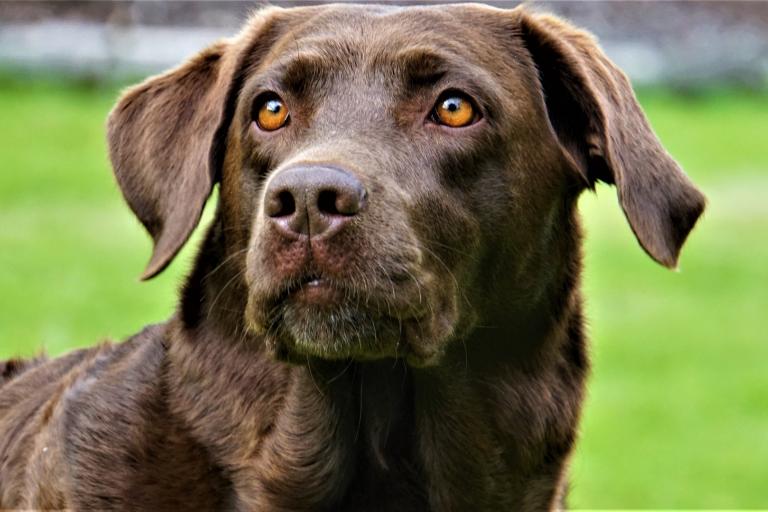Brown (Coat colour B-Locus Dog)
The dark pigment eumelanin is lightened to brown. The dog has a chocolate or liver brown coat colour. The skin also becomes lighter, recognisable on the nose and muzzle. Three recessive mutations (b-c, b-d, b-s) in the TYPR1 gene (B locus) lead to the lightening of eumelanin.
Genetic Test: available in Shop
General Information
- The black pigment eumelanin (black colour E/E, E/e) is altered to brown (chocolate or liver brown, in some breeds also called red or fawn) .
- The skin, recognisable on the nose and muzzle, also becomes lighter.
- There are three recessive alleles, each responsible for brown (b-c, b-d, b-s).
- Because of the double chromosome set of each animal, 3x2 = 6 DNA variants within the gene would thus have to be determined and evaluated with regard to their overall effect.
- Two non-functional copies cause the black pigment to lighten to brown.
- This may be a homozygous altered genotype at one of the 3 sites or a mixed genotype at 2 of the 3 sites. The genotype result for this would be b/b in each case.
- According to this rule, one mutation at the b-c locus and a second mutation at the b-d locus would be found to be b/b.
- However, our studies on dachshunds have shown that the mutations at the b-c and b-d locus are not independent, but also occur linked.
- Linked mutations act like a single mutation, so that the genotype finding b/b according to the nomenclature would be correct here, but would not lead to a brown coat colour.
- To differentiate between linked and independent mutations, we use the following abbreviation to designate the plant for the linked mutation: b2cd.
- A heterozygous, not brown animal would then have the finding: B/b2cd at the B locus.
Effects of/on other loci:
- E locus: Only the pigment eumelanin (black colour) can be lightened (E/E or E/e), the pigment phaeomelanin (e/e) is not affected. In the phenotype of dogs with a light base colour (e/e), the colour brown is not visible, but they may be carriers of the colour, recognisable by the skin on the muzzle and eyes lightened to brown.
- K locus: Dominant black can be lightened to the colour "brown" by the b-allele of the B-locus.
Test Information
Locus Information: B-Locus
This test detects the alleles b-c, b-d and b-s.
Test in Shop
Also in the:
Genotype and Lab Report
Inheritance: autosomal recessive
→ Only animals with two copies of the mutation (b/b) have the colour brown. Animals with only one copy or without mutation do not show the colour.
Genotypes
B/B = Two functional copies
Eumelanin is not altered, the dog does not have the colour brown.
B/b = One copy intact and one copy non-functional
Eumelanin is not altered, the dog does not have the colour brown.
b/b = Two non-functional copies
Eumelanin is altered, the dog has the colour brown.
Appearance
Brown/Chocolate/Liver-brown
The dog shows a dark base colour lightened to brown, also the skin becomes lighter, recognisable at the nose and eye rims. In the Labrador Retriever the colour is usually called chocolate brown or liver brown. The colouration occurs in many other breeds.
Possible genotypes:
E/* b/b
Brown/Chocolate
In both cases, the dogs have a dark base colour with "black-and-tan". On the left, the black pigment eumelanin is lightened to Brown, on the right it is not and the dog retains the black colour. The lighter colouring of the skin on the nose and muzzle is also clearly visible.
Possible genotypes:
Left: E/* at/* ky/ky b/b
Right: E/* at/* ky/ky B/*
Literature
Schmutz, S.M., Berryere, T.G., Goldfinch, A.D.: TYRP1 and MC1R genotypes and their effects on coat color in dogs. Mammalian Genome 13:380-387, 2002. Pubmed reference: 12140685. DOI: 10.1007/s00335-001-2147-2
Further information is available at Online Mendelian Inheritance in Animals.

